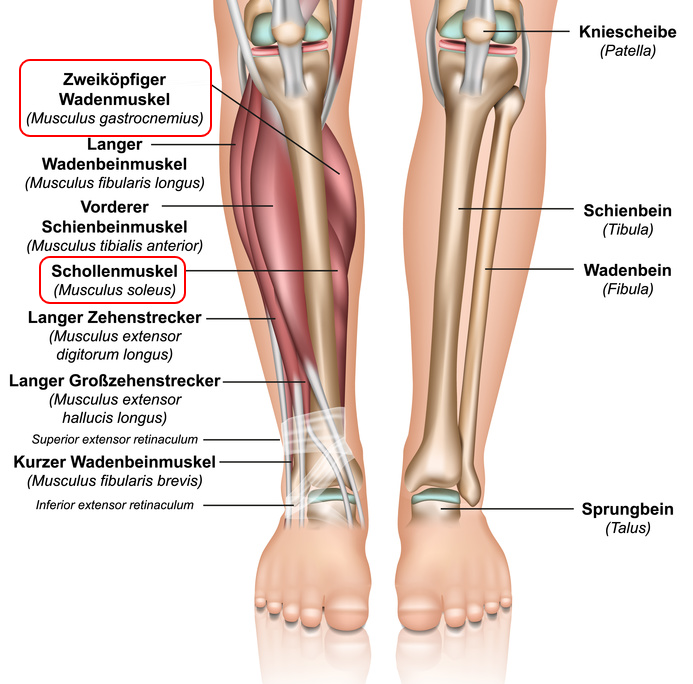The calves are arguably the least popular muscle group to train. It takes a lot of work to grow an impressive set of calves, especially if your genetics let you down in this area. Top bodybuilder Dennis Wolf can talk about it.
THE MUSCLE
The calves are – in case you didn’t know it – at the back of your lower leg. Your calves generally refer to the superficial gastrocnemius muscle and the soleus muscle below it.
Gastrocnemius literally means “stomach of your calves”, a reference to the muscle’s characteristic shape. It is a two-headed muscle, made up of a medial (inner) and a lateral (outer) head, running from your knee to your heel. Special about the muscle is its muscle fiber structure. The muscle fibers of the gastrocnemius are arranged diagonally, with a tendon in the middle, similar to a herringbone or bird feather. This is in fact the strongest muscle fiber structure. This means that a muscle with this muscle fiber type can generate a lot of force, but on the other hand also gets tired quickly due to its high proportion of ‘fast’ type II muscle fibers.
The soleus, which means ‘sandal’, is hidden behind the gastrocnemius. In anatomy, it is not yet entirely clear whether this muscle belongs to the gastrocnemius or whether it should be considered a separate muscle. In any case, the fact is that the muscles are partly separated. The muscle fibers of the soleus are also oriented differently from those of the gastrocnemius and the number of ‘slow’ type I muscle fibers is relatively high. As a result, the muscle has different properties and needs to be trained differently.

In this light we should note that you cannot train the gastrocnemius and soleus separately, isolated if you will. In fact, you have to train the calves in two different ways. But more on that later. Let’s first look at the function of the calf muscles.
FUNCTION
The calf muscle is responsible for plantar flexion, ie moving the foot downwards, such as when you stand on your toes. The muscle, along with the hamstrings, at the back of your thigh, is also responsible for bending the knee joint.
TRAINING CALVES: TIPS
In the gym calves are mainly trained with various variants of calf raises and calf presses. Also, remember that your calves are already involved—as an accessory or stabilizer—in strenuous leg exercises like the squat and leg press. It is wise to train the calves both standing and sitting, or with stretched and bent knees, because of the different position in which your calf muscles are then.
It is best to do calf exercises with free weights such as a barbell and dumbbells, rather than using machines. The calf muscles, especially the soleus, have an important stabilizing role. Simply put, they prevent you from falling over when you stand still. You neglect that role if you train the calves on a device.
It is also important to know that, with limited strength development, at least during the concentric, or positive phase of the movement, the soleus is mainly at work, while the gastrocnemius is mainly activated in the eccentric, or negative phase. It is therefore important to carry out the negative phase of your calf exercises in a controlled manner.
Finally, because of the mix of fast and slow muscle fibers, it is important to train your calves with a mix of low and high numbers of repetitions and heavy and light weights respectively. And by high we don’t mean 12 reps, but even 25 reps per set or more, until you can no longer do a repetition due to acidity.
For heavier reps, focus on an explosive output. The calves are involved in many explosive movements in daily life , such as sprinting and jumping. An unconventional exercise such as the jump squat is therefore a great calf exercise. Sprints and hill sprints (sprints uphill) are also excellent exercises for the calves. Perhaps even better than the standard exercises you do in the gym. Just look at the calves of the average hockey player, rugby player and football player – practitioners of sports in which many a sprint is made.